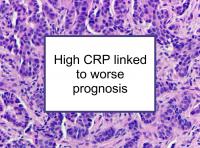A new study has reported that elevated C-reactive protein (CRP) levels at the time of diagnosis are associated with breast cancer outcomes, especially for those with (HER2+) disease. C-reactive protein, which is produced in the liver in response to infection or injury, is a measure of inflammation.
Breast cancer growth, invasion and metastasis all are promoted by inflammation. The study included Danish 2,910 women who were followed for up to seven years after being diagnosed with invasive breast cancer (median follow-up: three years). C-reactive protein was measured at the time of diagnosis. A total of 383 women died during follow up, of whom 225 died from breast cancer, and another 118 women had a recurrence (without dying during follow up).
Elevated C-reactive protein levels at the time of diagnosis were found to be associated with reduced overall and disease-free survival. Women in the highest third of C-reactive protein levels were approximately twice as likely to die from any cause as those in the lowest third. Five-year survival was 90% among low C-reactive protein women compared to 74% for high C-reactive protein women, disease-free survival was 87% compared to 74%, and breast cancer-specific death was 11% compared to 20%. Breast cancer-specific death was 1.7 times more likely among the women with high C-reactive protein levels. Women with C-reactive protein levels of 16.4 mg/L or higher (95th to 100th percentile) were 3.6 times more likely to die than women with levels under 0.78 mg/L (0 to 25th percentile). Among women with tumors, those with the highest compared to the lowest third of C-reactive protein levels were 8.6 times more likely to die from any cause during the study period.
The authors conclude that elevated C-reactive protein levels at the time of diagnosis of breast cancer are associated with reduced overall and disease-free survival and with increased risk of death from breast cancer. In a separate interview, lead author Kristine Allin said, “Elevated CRP at time of diagnosis remained predictive of overall survival rates regardless of patient's age, tumor size, lymph node status, or presence of metastasis, and whether or not the patient was estrogen receptor positive. It was still true even when we excluded patients which we believed to have bacterial infections because of their very high CRP levels.”
She further commented that “measuring CRP levels for breast cancer patients seems to be an easy way to predict the severity of the patient's disease. This may allow clinicians to alter their treatment tactics and improve cancer survival rates.”
